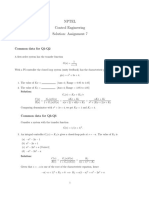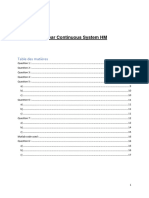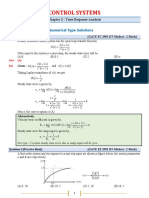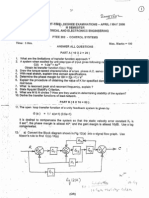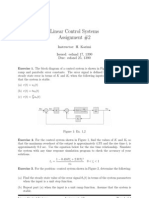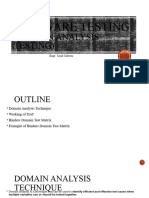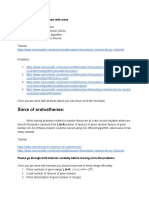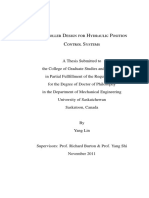NPTEL Online Course (Jan - May 2025)
Control Engineering
Instructor: Dr. Ramkrishna Pasumarthy
Indian Institute of Technology, Madras
Solution - Assignment 3
1. Blocks G2 and G3 are in parallel and hence reducing those blocks we get,
Blocks G1 and G2 + G3 are in cascade and hence reducing those blocks and shifting the
summer block after block H1 we get,
Removing the summer block with two parallel lines and taking its effect in feedback as
well as forward path, we get,
1
� Block G4 H2 is in parallel with one and hence, reducing those blocks, we get,
These blocks are in series,s and we finally get the transfer function of the system given by,
C G1 G2 + G1 G3 + G1 G2 G4 H2 + G1 G3 G4 H2
=
R 1 + G1 G2 H1 H2 + G1 G3 H1 H2
The correct option is (a)
2. Joining all the nodes and as per the given equations to get the signal flow graph as shown
in the figure,
Forward paths: T1 = abcd, T2 = ag Individual feedback loop gains are: Loop 1:
Loop 2:
Loop 3:
L1 L3 and L2 L3 are combinations of 2 non-touching loops.
∆ = 1 − [L1 L2 L3 ] + [L1 L3 + L2 L3 ]
2
� For T1 , all loops are touching hence ∆1 = 1 For T2 , L1 is non-touching hence ∆2 = 1 − L1
Transfer Function is given by:
x5 T1 ∆1 + T2 ∆2 abcd + ag(1 − ce)
= =
x1 ∆ 1 − ce − dh − f + cef + dhf
The correct option is (d)
3. First, we shift G1 ahead of the second summing block and shift G4 before the second take
off point as below.
Note that we can interchange the first and second summing blocks as follows.
Now, we can simplify the inner two negative-feedback loops to get the following.
Finally, the outer positive-feedback loop gives
Y (s) G1 G2 G3 G4
= .
R(s) 1 + G1 G2 H1 + G3 G4 H2 − G2 G3 H3 + G1 G2 G3 G4 H1 H2
The correct option is (c)
3
�4. From the electrical network, Applying KVL in the first loop,
Vi (s) = I1 (s)[Z1 (s) + Z3 (s)] − I2 (s)Z3 (s)
So,
Vi (s) I2 (s)Z3 (s)
I1 (s) = + (1)
Z1 (s) + Z3 (s) Z1 (s) + Z3 (s)
Applying KVL in the second loop,
[I2 (s) − I1 (s)]Z3 (s) + I2 (s)Z2 (s) + I2 (s)Z4 (s) = 0
[I2 (s)[Z2 (s) + Z3 (s) + Z4 (s)]] = I1 (s)Z3 (s)
Z3 (s)
I2 (s) = I1 (s) (2)
Z2 (s) + Z3 (s) + Z4 (s)
From the signal flow graph,
I1 (s) = Vi (s)G1 (s) + I2 (s)H(s) (3)
I2 (s) = G2 (s)I1 (s) (4)
Comparing equations (1) and (2), we get:
Z3 (s)
H(s) = (5)
Z1 (s) + Z3 (s)
Comparing equations (2) and (4), we get:
Z3 (s)
G2 (s) = (6)
Z2 (s) + Z3 (s) + Z4 (s)
The correct option is (c)
5. The overall open-loop transfer function here is
K
G(s) = .
sa (s
+ 10)
Since we want a non-zero, finite steady-state error for a ramp input, the system must be
of type 1, hence a = 1. Further, the exact value of the error is ess = 0.2. So,
1 1 1 10
0.2 = ess = = = K
= .
Kv lims→0 sG(s) lims→0 s s(s+10) K
Thus, K = 50.
The correct option is (a)
4
�6. Given transfer function,
Y (s) 64
= 2 (7)
R(s) s + 8s + 64
The general form of the transfer function of a 2nd order system is given by:
Y (s) ωn2
= 2 (8)
R(s) s + 2ζωn s + ωn2
Comparing equations (7) and (8), we get:
ωn2 = 64
∴ ωn = 8
2ζωn = 8
∴ ζ = 8/16 = 0.5
p
ωd = ωn 1 − ζ 2
p
∴ ωd = 8 ∗ 1 − 0.52 = 6.93
The correct option is (a)
7. Without factor: Open loop transfer function:
10
G(s)H(s) =
s(s + 2)
Closed loop transfer function:
C(s) G(s) 10
= = 2
R(s) 1 + G(s)H(s) s + 2s + 10
Comparing with the standard equation, we get:
ωn = 3.16, ζ = 0.316
Velocity error coefficient:
Kv = lim sG(s)H(s)
s→0
s × 10
= lim =5
s→0 s(s + 2)
Steady-state error:
1 1
ess = = = 0.2
Kv 5
The correct option is (c)
5
�8. With factor: Closed loop transfer function:
C(s) G(s)
=
R(s) 1 + G(s)H(s)
KA
= 2
s + (2 + K0 )s + KA
10
= 2
s + (2 + K0 )s + 10
Comparing with the standard equation, we get:
ωn = 3.16, 2ζωn = 2 + K0
For ζ = 0.6:
2 × 0.6 × 3.16 = 2 + K0
Solving for K0 :
K0 = 1.8
Velocity error coefficient:
Kv = lim sG(s)H(s)
s→0
s × 10
= lim = 2.63
s→0 s(s + (2 + K0 ))
Steady-state error:
1 1
ess = = = 0.38
Kv 2.63
The correct option is (b)
9. According to the given block diagram, the transfer function will be:
C(s) k
= 2
R(s) s + T ks + k
Comparing with the standard form of a second-order transfer function:
ωn2 = k, 2ζωn = T k
Maximum overshoot:
√
2
Mp = 1 − e(−ζπ/ 1−ζ )
Given Mp = 0.20:
√
2
0.20 = 1 − e(−ζπ/ 1−ζ )
Solving for ζ:
ζ = 0.46
6
� Peak Time:
π
Tp = p
ωn 1 − ζ 2
Given ζ = 0.46 and Tp = 2, solving for ωn :
ωn = 1.76 rad/s
Now,
k = ωn2 = (1.76)2 = 3.09
Solving for T :
2ζωn 2 × 0.46 × 1.76
T = = = 0.52
k 3.09
The correct option is (c)
10. Let the open-loop transfer function be:
k
G(s)H(s) =
1 + sT
For a unit ramp input:
sk
Kv = lim sG(s)H(s) = lim =k
s→0 s→0 1 + sT
Steady-state error:
1 1
ess = =
Kv k
From the above expression, it is clear that increasing the gain k reduces the steady-state
error. The correct option is (d)






